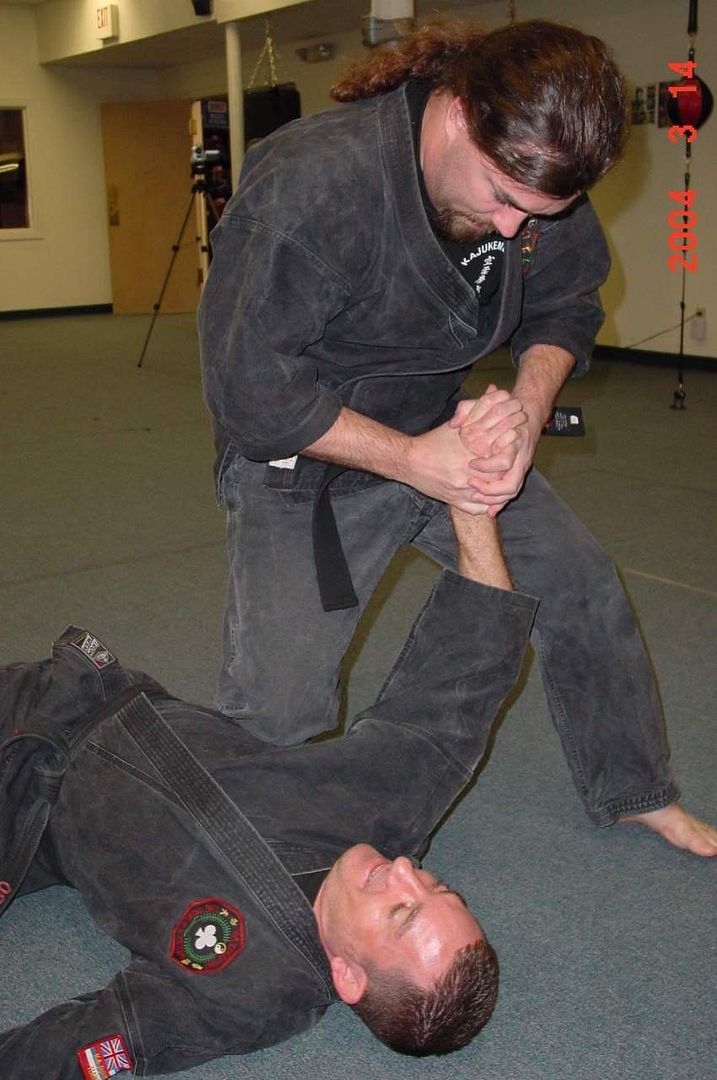
I’d like to thank everyone for their very detailed comments to my last post (Joint locking – how useful is it really?) I’ve had over 3000 words of comments to read, think about and digest so I think your efforts are worthy of me writing another post in way of reply!
Having taken on board your comments I now have a few more thoughts to express on the subject of joint locking…
Situations when locks may be useful:
In my first post I was a little negative about how or when I would ever be able to apply a lock if I was attacked. Felicia pointed out that women, on the whole, are attacked by people they know and as Charles James correctly said this is a predator/prey situation, rather than a ‘monkey dance situation’. The predator will often prepare/groom their prey before attacking. Identifying that you are being ‘groomed’ for an assault is obviously an important part of a woman’s self-defence training and thoughts about it are probably worthy of a future post.
Sarah pointed out that such situations occur in bars/public places, on dates, where the man over-steps the boundaries/gropes you etc. I think that this is an important stage in an assault i.e. at the beginning before it gets really nasty when a lock, quickly applied, may be useful even if it’s just as a warning to him that you are not easy prey…
I can also see locks being successfully applied at the end stage of an assault (or more correctly – to end the assault) i.e. to control and restrain. Clearly many of you, Journeyman, Open Hand, Rick and John Coles have used locks successfully to control people in a professional capacity. I would not dare to argue with your experience – if you say locks work in these situations then I believe you. I generally see this use of joint locking as the domain of the ‘professionals’ but I could also see a situation where I would attempt to restrain an attacker – if I was in a public place and I knew help was at hand or on its way to take the restrained person off me…
Applying the lock:
This is the area where I have the most difficulty visualising locks working in practice. I can see how I may get a wrist or arm lock applied if the attackers first move was a grab to my wrist, arm, lapel or even throat. If I was quick enough I could get a wrist or arm lock straight on. I can see that working, probably because it best reflects the way I’ve been training in joint locking techniques.
However, if I miss that opportunity and the assault continues I then have to wait for an opening or opportunity to get a lock on. OpenHand suggests creating that opportunity rather than waiting for it but didn’t explain how one does that. Journeyman advised to always slap the attacker in the face before applying a lock to distract them from what you are about to do and therefore lower their resistance to the technique. I suppose this is a way of ‘creating the opportunity.’
It seems to me that though it may be possible to create the opportunity to apply a lock one shouldn’t merely wait for an opening. If you are thinking too much about whether or not you can get a lock on then you may not remain ‘in the moment’ during the assault and respond with whatever technique is most appropriate at that point in time. Creating the opportunity to apply the lock seems the best way and I would welcome any other suggestions on how to do that…
Does size matter?
I suggested in my last post that I felt disadvantaged in a self-defence situation by my small size; that techniques, including locks, may not work effectively for me. A couple of commenters, OpenHand and Journeyman, disagreed with this view point saying that size and strength differences between attacker and defender shouldn’t matter. I have heard others say the same thing. However, experience, both my own and other ‘small’ people that I know suggest that size does make a difference.
In my opinion it’s not so much height differences between attacker and defender that matter (though they matter a bit) but differences in overall mass, particularly when it comes to any form of grappling technique. When I look around my jujitsu club the most proficient people are the ones with greatest mass, whether that mass comes from sheer height and muscle or just surplus body weight (i.e. fat). Even the black belt women in the club are stocky lasses, no taller than me but much heavier. Small skinnies like me just can’t cut the mustard in a grappling/throwing art when we are pitted against a much heavier opponent.
In all sports and physical activities different body forms suit different sports. Sprinters and swimmers are generally tall and muscular, long distance runners are smaller and wiry, pole-vaulters are tall and slim, and jockeys are small and light. Good technique cannot make up for being the wrong body form for the activity you are doing. There’s a reason why wrestlers, boxers and MMA fighters fight in weight categories.
When it comes to locks my small, slim hands have a lot of difficulty applying a wrist lock to a large man’s muscular wrist. Journeyman stated that, “Just like you can’t flex your throat, you can’t strengthen your joints. Pounds of pressure required to dislocate a joint are largely the same, regardless of individual. It is for this reason that I recommend joint locks and manipulations for smaller individuals, regardless of sex.”
I disagree with this – a lot of physiotherapy exercises are designed to strengthen the muscles that support joints thus making the joint more stable and resistant to injury. Though I agree that the amount of pressure needed to dislocate the joint may not differ between individuals the amount of pressure needed to initially twist a limb into position for a lock varies enormously. I often don’t have the strength to physically manoeuvre a muscular man’s wrist or shoulder into the position needed to lock the joint. Also some men’s necks are so thick and muscular I cannot even place my hands around them or squeeze sufficiently hard to cause any discomfort at all!
Another problem I have dealing with a much larger opponent is applying a shoulder lock. I have to reach up to slip my hand under their armpit and onto their shoulder , and then push down from a very disadvantaged position – I’m actually pulling down rather than pushing because my centre of gravity is lower than theirs. “Bring them down to your height first,” you may say but honestly – that’s easier said than done!
So, what have I learnt about joint locking following your feedback?
1. Locks may be applicable to me in some situations so I need to keep training with them (and learning counters to locks)
2. Locks work best when you create the opportunity to apply them
3. Size differences between attacker and defender may or may not be relevant – but if you want to convince me they are not then you’ll need to provide me with a good rational scientific explanation and with some tips on how small people can make techniques work on big people because I’m not yet convinced ;-)
Thanks again for everybody who contributed to the discussion on my previous post – a real team effort!

This work is licensed under a Creative Commons Attribution-Noncommercial-Share Alike 2.0 UK: England & Wales License.


